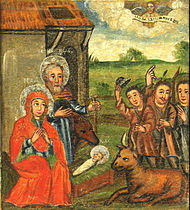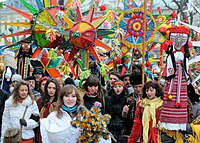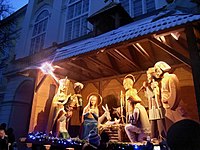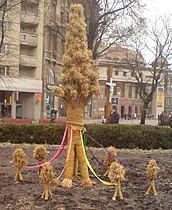Christmas in Ukraine
| Christmas in Ukraine | |
|---|---|
 | |
| Also called | Ukrainian: Різдво, Rizdvo |
| Observed by | Christians, many non-Christians |
| Type | Christian, cultural |
| Significance | Commemoration of the Nativity of Jesus |
| Celebrations | Gift-giving, family and other social gatherings, symbolic decoration, feasting etc. |
| Observances | Church services |
| Date |
|
| Frequency | Annual |
Traditional Ukrainian Christmas festivities start on Christmas Eve, which is celebrated on 6 January, as reckoned by the Julian calendar. The Christmas celebrations end on 19 January, the date of the celebration of the Baptism of Jesus, known in Ukraine as Vodokhreschhe (Водо́хреще) or Yordan.[4]
As of 2017, 25 December, Christmas Day by the Gregorian calendar, became an official government holiday in Ukraine. The Eastern Orthodox Church and Ukrainian Greek Catholic Churches predominantly follow the Julian calendar, and 7 January is also a public holiday in Ukraine.[5][6] In December 2020, the head of the Orthodox Church of Ukraine, Metropolitan Epiphanius, said that changing the date of Christmas to 25 December in Ukraine is possible after both the church and the faithful are ready for such a decision, after conducting educational work. It was stated that the postponement of the Nativity of the Lord would entail a change in the dates of all fixed holidays to 13 days ago.[7] In December 2020, the head of the UGCC, Patriarch Sviatoslav, stated that the Greek Catholic Church would resolve this issue "together with our Orthodox brothers." He also noted that this issue is not dogmatic, it should overcome church divisions, not cause new ones, and in his opinion, the transition to celebrating Christmas in a new style — 25 December, should be initiated by the laity.
On October 18, 2022, the Orthodox Church of Ukraine allowed dioceses to hold Christmas services according to the Revised Julian calendar, i.e., December 25. In the case of a divine service, its participants are released from the restrictions of fasting on this day.[8]
Sviatyi Vechir (Holy Evening)
Christmas Eve is called Sviatyi Vechir (Святий вечір) or Sviatvechir (Святвечір) in Ukraine ("Holy Evening"), and has many customs and rituals, most of which predate the introduction of christianity to Ukraine. Traditions include decorating house and dinner table with special attributes (a symbolic sheaf of wheat called the didukh, garlic, hay, and others), performing koliadky ('carols') and so on. Each ritual has its own meaning and purpose, as such a few wisps of hay on the embroidered tablecloth as a reminder of the manger in Bethlehem. One prominent custom of the night is a special supper, called Sviata Vecheria ("Holy Supper").[9]
Ukrainians fast on Sviat vechir; only when the first star is seen in the evening sky, may the supper begin. The family comes together to have a dinner which usually includes 12 dishes (the number can vary from 7-17). These twelve dishes are traditionally vegan plus fish, and do not contain meat, milk, or eggs. [10] While the dishes served can vary regionally, as well as from family to family, the two mandatory dishes are uzvar and kutia, both reckoned by ethnographer Khvedir Vovk to be remnants of ancient rituals which date back to the neolithic era.[11] Kutia (a dish of grain, honey and poppy seeds) is traditionally served first at the meal, after being offered by the head of the household to the frost. A spoonful is tossed at the ceiling, and the number of poppy seeds which stick portends the fruitfulness of the fields and farm animals in the coming year. It is rarely served at other times of the year.[12] Uzvar is a beverage, made with cooked dried fruits and berries. It can be mixed in with the kutia, or served separately at the end of the meal. Servings of both dishes are also set aside overnight in the pokuttia, the corner of the house with the icons, for the ancestors.
Koliadky (Caroling)
At the end of the Sviata Vechera the family often sings carols (koliadky, singular koliadka). In many communities the ancient Ukrainian tradition of caroling is carried on by groups of young people and members of organizations and churches calling at homes and collecting donations. A well-known carol is "Boh predvichnyi narodyvsia".[13]
Didukh (Grandfather)
In villages (farming communities), the head of the household brings in a sheaf of grain called the didukh which represents the importance of the ancient and rich wheat crops of Ukraine, the staff of life through the centuries. Didukh means literally "grandfather spirit" so it symbolizes the family's ancestors. In Ukrainian city homes the didukh may be purchased, and is often three footed made of woven grain and dried grasses and flowers.[citation needed]
Shopka (Nativity scene)
A shopka is a traditional portable nativity scene used to represent nativity and other figures in a puppet form.[citation needed]
Gallery
-
2006 Christmas stamp, showing St. Nicholas and children.
-
Religious painting showing the Adoration of the Shepherds.
-
Caroling in Lviv.
-
A didukh in Lviv.
Further reading
- Kutia, Star of the Ukrainian Christmas Eve Supper
- Kylymnyk, Stepan, 1955–1969; Ukrainskyi Rik u Narodnykh Zvychayakh v Narodnomu Osvitlenni [Ukrainian Year in Folk Customs from Historical Perspective], Winnipeg, Toronto
- Tracz, Orysia 2015, First Star I See Tonight, Mazepa Publications Zhuravli, Winnipeg
- Ukrainian Christmas Traditions, Ukrainian International Directory
- Voropai, Oleksa 1958, Zvychai Nashoho Narodu [Customs of Our People], Ukrainske Vydavnytstvo, Munich
- Yakovenko, Svitlana 2016, Ukrainian Christmas Eve Supper: Traditional village recipes for Sviata Vecheria, Sova Books, Sydney
See also
References
- ^ Martindale, Cyril Charles (1908). "Christmas". The Catholic Encyclopedia. Vol. 3. New York: Robert Appleton Company.
- ^ Gwynne, Paul (2011). World Religions in Practice. John Wiley & Sons. ISBN 978-1-4443-6005-9.
- ^ Ramzy, John. "The Glorious Feast of Nativity: 7 January? 29 Kiahk? 25 December?". Coptic Orthodox Church Network. Archived from the original on 28 December 2010. Retrieved 17 January 2011.
- ^ Christmas Traditions
- ^ "Ukraine seeks distance from Moscow with new Christmas holiday". m.digitaljournal.com. 16 November 2017. Retrieved 16 November 2017.
- ^ (in Ukrainian) "Рада зробила 25 грудня вихідним днем". BBC Україна. 16 November 2017. Retrieved 16 November 2017.
- ^ "Епіфаній назвав умову перенесення святкування Різдва на 25 грудня".
- ^ "OCU allowed Christmas services on December 25". Ukrainian Pravda (in Ukrainian). Retrieved 18 October 2022.
- ^ Inc, World Book (1997). Christmas in Ukraine. World Book .com. ISBN 978-0-7166-0897-4.
{{cite book}}:|last=has generic name (help) - ^ "Christmas in Ukraine". Why Christmas. Retrieved 14 December 2020.
- ^ "Traditional Recipe of Ukrainian Kutia". Ethnocook. Retrieved 27 November 2022.
- ^ Sviat Vechir
- ^ "Boh predvičnyj". Metropolitan Cantor Institute. Byzantine Catholic. Archived from the original on 4 March 2016. Retrieved 12 August 2015.






